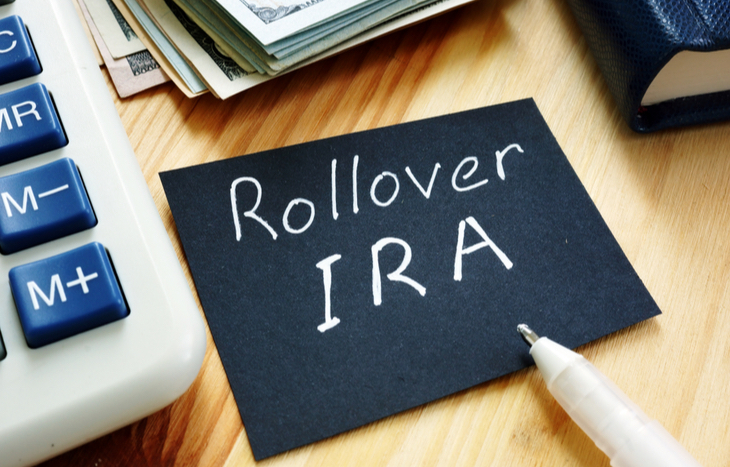What is an IRA Rollover?
An IRA (individual retirement account) rollover is a transfer of funds from one retirement account to a traditional or Roth IRA. The rollover is used to move assets from a 401(k) or similar retirement accounts. The funds can then be used with either a new employer’s retirement plan or another account provider.
One main benefit of an IRA rollover is keeping your money safe from taxes. There is no maximum amount you can roll over. They can also provide a larger selection of investments. Let’s look at the details…

Direct vs. Indirect Rollover
The first, and preferred, rollover method is a direct rollover. Your money goes straight from one account to the other. For example, a wire transfer of funds. The other direct method is a check written from your previous provider to the IRA account provider. The money never touches your hands.
With an indirect rollover, you can have issues with the IRS because the money is given to you via check. If all the funds are not rolled over within a 60-day period (starting from the day you receive the distribution), the money is subject to income tax. There’s also a 10% early distribution penalty if you’re under the age of 59½. The next section covers more IRA rollover tax details…
Note: You may qualify for an extension on the 60-day rule. To find out, check out the IRS 60-Day Waiver FAQ.
Taxes on Distribution Rollover
There are no taxes on a direct rollover. However, if you decide to do an indirect rollover, there are some things to keep in mind. The first, as previously mentioned, is the 60-day rule. The other is that when you receive the check from your former plan, it will be for the full amount minus 20% for distribution taxes. However, you can get this money back by rolling over the full amount of your distribution, including the 20% withheld.
For example, you receive a distribution of $10,000. Your check will be for $8,000 – after the 20% ($2,000) is withheld. To roll over the full distribution amount, you must come up with $2,000 to bring the total to $10,000. If you’re able to do that, the IRS will note you rolled over the full amount and refund the $2,000 that was withheld. If you roll over only the $8,000 and don’t contribute the full $10,000, the IRS will view it as an early distribution. You will owe income taxes on the $2,000 and be assessed a 10% early distribution penalty.
With rollovers from a 401(k), your plan gets pretax contributions. Because of this, rolling the distribution to a traditional IRA is often the better choice since they are also pretax. On the other hand, you can roll the distribution to a Roth IRA, but you will have to pay taxes. Roth IRAs have post-tax contributions. The exception to this is if you have a Roth 401(k).
IRA-to-IRA Rollover Rules
In addition to rolling over from employer-sponsored plans, there are IRA-to-IRA rollovers. Only one rollover is permitted within a 12-month period (one calendar year from the date in which the account holder made the distribution). During this period, you cannot make another IRA-to-IRA rollover no matter how many IRAs you may have. This rule does not apply to the following types of transfers:
- Traditional-to-Roth (conversions)
- Trustee-to-trustee to IRA
- IRA-to-plan
- Plan-to-IRA
- Plan-to-plan.
With this rule, you must include any previously untaxed amounts from an IRA distribution as gross income, and that amount may be subject to the 10% early distribution penalty.
For more information on allowed rollover transactions, the IRS has a Rollover Chart.
What Distributions Can Be Rolled Over?
You can roll over most IRA distributions. The only exceptions to this rule are required minimum distributions or a distribution of excess contributions and the related earnings.
As mentioned in this article, you can roll over your retirement distributions. However, there are a few more exceptions. The exceptions are:
- Required minimum distributions
- Loans as distribution
- Hardship distributions
- Excess contributions and related earnings
- Distribution one of a series of substantially equal payments
- Withdrawals electing out of automatic contribution arrangements
- Distributions for accident, health or life insurance
- Dividends on employer securities
- S corporation allocations treated as distributions
Bottom line, IRA rollovers have many benefits. They can help you save taxes, consolidate accounts and gain more investment options. So you might want to consider rolling over your old or future accounts. Also, if you’re looking for more retirement and investing insight, check out our free e-letter. It’s packed with useful tips. You can sign up below…
[adzerk-get-ad zone="245143" size="4"]About Amber Deter
Amber Deter has researched and written about initial public offerings (IPOs) over the last few years. After starting her college career studying accounting and business, Amber decided to focus on her love of writing. Now she’s able to bring that experience to Investment U readers by providing in-depth research on IPO and investing opportunities.





